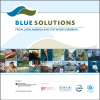Blue solutions from Latin America and the wider Caribbean

This publication is a result of Blue Solutions’ second Regional Forum on Solutions for Oceans, Coasts and Human Well-being in Latin America and the Wider Caribbean Region. This four-day workshop was held in Cancún, Mexico in April 2015.


